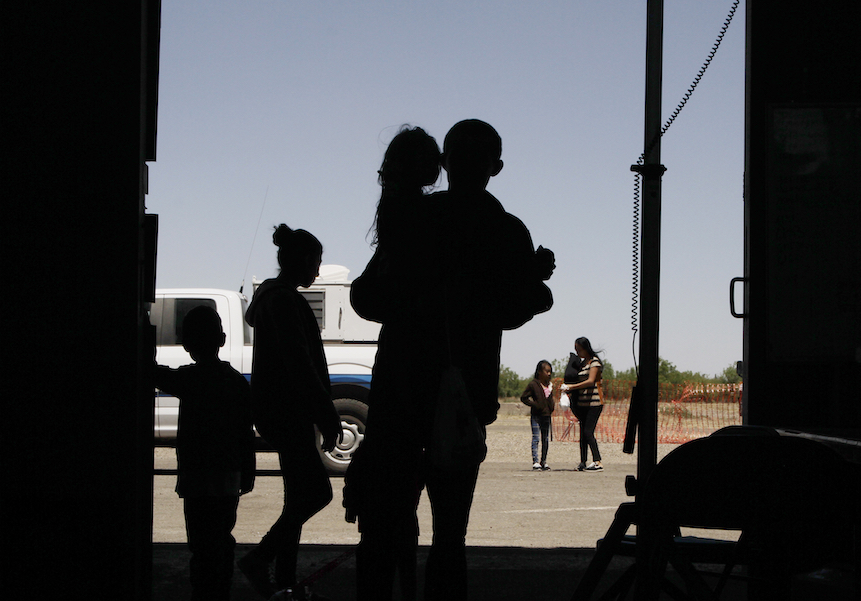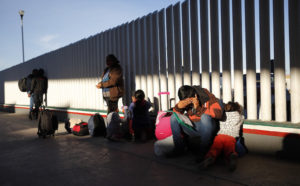Trump’s Lies Destroy Immigrants’ Lives
The harrowing headlines about people killed trying to cross the U.S.-Mexico border tell only one part of the complex story on the ground. Immigrants guide their children through the entrance of a World War II-era bomber hanger in Deming, N.M. (Cedar Attanasio / AP)
Immigrants guide their children through the entrance of a World War II-era bomber hanger in Deming, N.M. (Cedar Attanasio / AP)
On June 17, a day before President Donald Trump tweeted his plans to arrest about 2,000 immigrants, 150 of them in Los Angeles, I happened to be in immigration court in L.A. I was there to observe the administration’s efforts to stop Mexicans and Central Americans from seeking asylum in the United States.
The downtown courtrooms are at the center of the Trump administration’s anti-immigrant drive, designed to stir up the conservative white nationalists who constitute much of the president’s electoral base. I’ve found this bureaucratic treadmill, with an infamously huge backlog of cases, a good place to observe the president’s team at the ground level.
By chance, I had picked an opportune time. Trump’s announcement, trumpeted through the internet, radio, television and the newspapers all the next day, spread terror through the country’s large communities of Central American and Mexican immigrants. Then, on June 22, the unpredictable president delayed the arrests of those scheduled for deportation. But the fear continued unabated. Trump promised to begin the arrests in two weeks unless his version of a $4.5 billion immigrant aid appropriation passes through Congress.
“Every enforcement causes trauma, especially to children,” said Victor Narro, an immigrants’ rights advocate, project director at the UCLA Labor Center and a law professor at the university. “We have traumatized an entire generation of children, and this will plague them the rest of their lives.”
Judy London, directing attorney of Public Counsel’s Immigrant Rights Project, told me what awaits the immigrants if the arrests and deportation orders are carried out. They will be taken to a room in the basement of the federal building and then to a detention center far from home. From there, they will be deported. Their families can give them a single suitcase for the journey.
Deportation is the final step of the process. But before that happens, immigrants get lost in the maze of the immigration court.
The courts were the subject of a scathing report released this month by The Innovation Lab and the Southern Poverty Law Center titled “The Attorney General’s Judges: How the U.S. Immigration Courts Became A Deportation Tool.” It charged, “After decades of neglect and abuse by prior attorneys general, the Trump administration is weaponizing the immigration court system against asylum seekers and immigrants of color … the attorneys general have actively sought to turn the immigration court system into a weapon of deterrence and deportation.”
There are 58 immigration courts in the United States, each with a judge appointed by the U.S. attorney general and serving at his pleasure. Overworked and faced with a huge backlog of cases, the judges run a judicial assembly line.
I joined a number of immigrants and their lawyers waiting for the nearby courtroom to open. It promised to be a busy afternoon. A lawyer told me Judge Veronica Villegas would hear 30 cases in the next four hours, a small part of the backlog of 908,552 cases pending in immigration courts around the country. Immigrants’ average waiting time for a hearing is 727 days, according to the foremost compiler of immigration statistics, the Transactional Records Access Clearinghouse (TRAC), maintained by Syracuse University.
Shortly before 1 p.m., the courtroom doors opened, and soon it was standing room only. Although I’d stood near the head of the line, I found a seat in the back row.
Immigration law is incredibly complicated, and without a lawyer, immigrants are usually doomed to deportation. That’s how 75% of the cases end.
I saw a man threatened with deportation to Mexico apply for asylum. His case would be heard in seven months, on Feb. 3, 2020. Until then, he would be out on bail if he could afford it, or if not, he would go to one of the notoriously overcrowded detention centers. A woman got a hearing on April 23, 2021. The hearing for another immigrant was scheduled for Oct. 12, 2021.
Trump and his team portray the immigrants as worthless, dangerous people who duck out of court hearings and disappear. Acting Secretary of Homeland Security Kevin McAleenan, the National Review reported, testified to a Senate committee that 90% of asylum-seekers skipped their hearings.
This is a lie. Examining the cases of families facing deportation, TRAC said those with legal representation showed up 99.9% of the time. The rate dropped to 81.6% for those without lawyers. One reason for the lower rate is that attorneys keep track of court dates for their clients. Court notices often miss the recipients without lawyers or are in English, which is no help to Spanish-only speakers.
Trump stirs up his supporters with the false charge that the immigrants are criminals. As he tweeted last October, “Many Gang Members and some very bad people are mixed into the Caravan heading to our Southern Border. Please go back, you will not be admitted into the United States unless you go through the legal process. This is an invasion of our Country and our Military is waiting for you!”
This is another Trump lie.
TRAC reports that “the vast majority (58 percent) of individuals in ICE custody had no criminal record. An even larger proportion—four out of five—either had no record, or had only committed a minor offense such as a traffic violation.” For those who had been convicted, their most frequent crime was entering the country without documents. The second most common was driving under the influence of alcohol.
Trump is peddling an ugly myth, one designed to ensure his re-election next year by stoking his supporters’ fear of immigrants. The images on television and in other media showed the toll: inhumane treatment of children at a Texas detention facility; the bodies of a father and his child on the banks of the Rio Grande.
This kind of rhetoric inflames feelings against immigrants who want nothing more than an escape from terror in their homelands and better lives—the same feelings that brought earlier generations to the United States.
As I have seen in the immigration courts, even worse damage is being done to those trapped in an anti-immigrant bureaucracy, where asylum is usually denied, and women and men and children are turned over to ICE police for a trip back to their dangerous hometowns and whatever fate awaits them.
Your support matters…Independent journalism is under threat and overshadowed by heavily funded mainstream media.
You can help level the playing field. Become a member.
Your tax-deductible contribution keeps us digging beneath the headlines to give you thought-provoking, investigative reporting and analysis that unearths what's really happening- without compromise.
Give today to support our courageous, independent journalists.









You need to be a supporter to comment.
There are currently no responses to this article.
Be the first to respond.